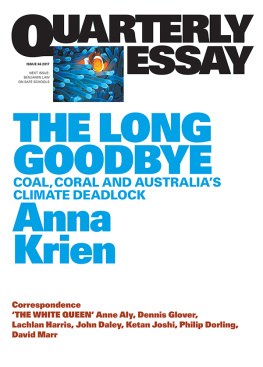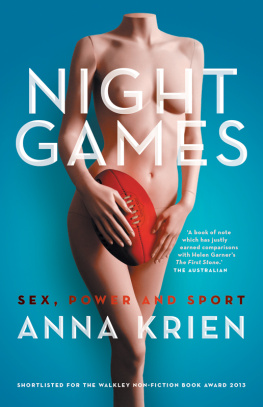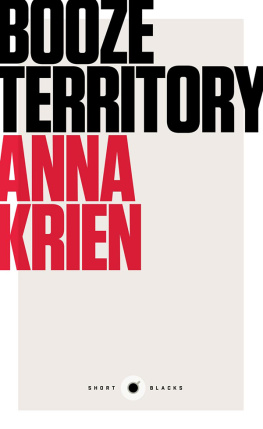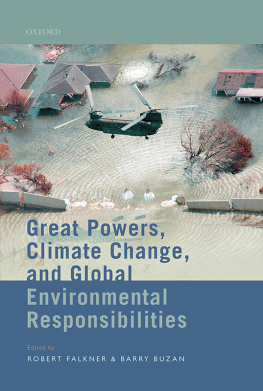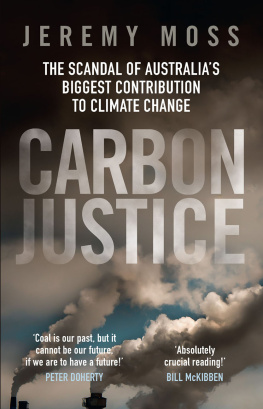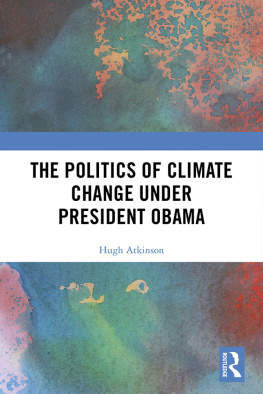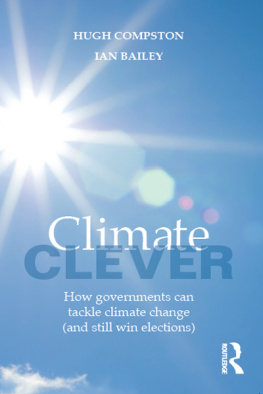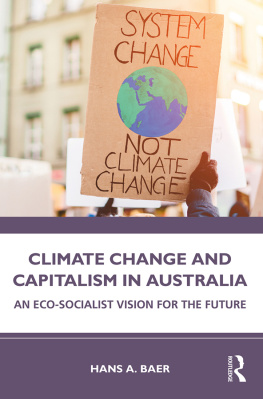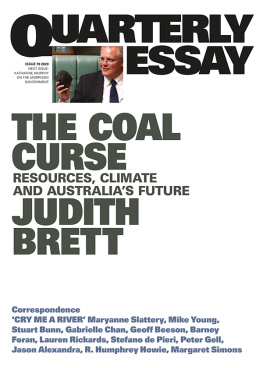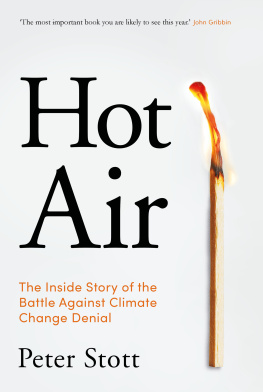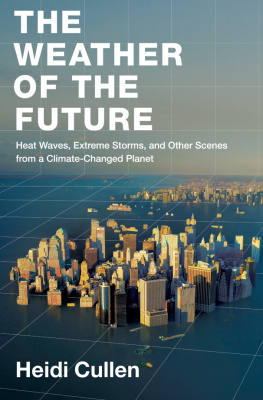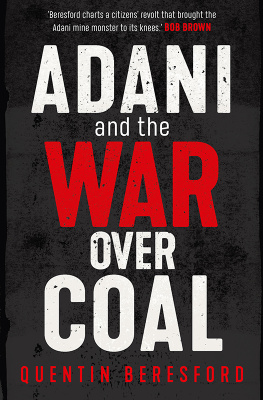Quarterly Essay is published four times a year by Black Inc., an imprint of Schwartz Publishing Pty Ltd. Publisher: Morry Schwartz.
ALL RIGHTS RESERVED.
No part of this publication may be reproduced, stored in a retrieval system, or transmitted in any form by any means electronic, mechanical, photocopying, recording or otherwise without the prior consent of the publishers.
Essay & correspondence retained by the authors.
Subscriptions 1 year print & digital (4 issues): $79.95 within Australia incl. GST. Outside Australia $119.95. 2 years print & digital (8 issues): $149.95 within Australia incl. GST. 1 year digital only: $49.95.
Payment may be made by Mastercard or Visa, or by cheque made out to Schwartz Publishing. Payment includes postage and handling.
To subscribe, fill out and post the subscription card or form inside this issue, or subscribe online:
Editor: Chris Feik. Management: Caitlin Yates.
Publicity: Anna Lensky. Design: Guy Mirabella.
Assistant Editor: Kirstie Innes-Will. Production
Coordinator: Hanako Smith. Typesetting: Tristan Main.
Printed in Australia by McPhersons Printing Group. The paper used to produce this book comes from wood grown in sustainable forests.
THE LONG GOODBYE | Coal, Coral and Australias Climate Deadlock |
Anna Krien |
I had no expectations. If anything, I was anticipating disappointment. Not so much because of premature obituaries of the Great Barrier Reef; it was more my distrust of adjectives. I have been to enough bucket-list tourist sites to know the experience can leave one feeling strangely empty. I sat next to the skipper, blue water whooshing underneath us, while, on the deck below, German backpackers organised their underwater cameras and diving gear. A few of us watched the shoreline, Townsville shrinking as we got further away. Castle Hill, a mass of orange granite that separates the city centre from the urban sprawl beyond, glowed in the pink morning light. Rusted to the landscape is Clive Palmers Yabulu nickel refinery, its three smokestacks no longer puffing. Theres a lush strand I had walked that morning on my way to the jetty, where black cockatoos hang upside down, tearing fruit off the trees as early morning joggers dodge the leaf litter. I passed a brightly painted water playground, its movement sensors waiting for the days first chubby bather-clad preschooler.
Its often said in news reports that you can see the Great Barrier Reef, the worlds largest structure made up of living organisms, from space as if that will convince us to protect it. But you can see a lot of things from space: Chinas smog, and the Super Pit, a goldmine in Kalgoorlie.
In 1968, on the first human voyage to orbit the moon, the American astronaut Bill Anders was given the job of photographer. The Apollo 8 mission was focused on the moon, but then...
ANDERS: Oh, my God! Look at that picture over there! Theres the Earth coming up. Wow, is that pretty.
BORMAN: Hey, dont take that, its not scheduled. (joking)
ANDERS: (laughs) You got a colour film, Jim? Hand me that roll of colour quick, would you...
LOVELL: Oh man, thats great!
Anders words are often repeated: We came all this way to explore the moon, and the most important thing is that we discovered the Earth. His photo, titled Earthrise, became a lightning rod for environmentalists, who knew the blue and green swirling globe coming out of the dark was a gift too precious to lose sight of. It is a difficult task, to remember we are on a cats-eye marble in a pitch-black void.
Are we in space? my four-year-old had asked me in Melbourne, not long before I left for my reef visit.
No, I replied confidently, then just as quickly lost confidence. Well, actually, we are. We are on Earth, and Earth is kind of wrapped, like a present [his eyes lit up], in our atmosphere, the sky, and all of this is in space. So we kind of are in space.
He nodded solemnly, absorbing this before continuing with his painting, but I was trembling. It was that strange feeling of having known something for a long time, but the act of saying it out loud making it real. We are in space. I wanted to scream it on the street like a crazy woman. We are in space!
Two hundred years of science and discovery have seen a rapid reorientation of many assumptions. The first dizzying insight was that of extinction, proved by paleontologist Georges Cuvier in 1796. It had been assumed until then that life just went on. Sure, it was punctuated by death, mostly in dribs and drabs, sometimes in tragic sweeps like the Black Death, but a species did not simply cease to exist. There would always be another specimen in its mirror image, and another, and another.
It got worse. Cuvier, discovering an increasing diversity of fossils, suggested there had been catastrophes on Earth, many of them. Life on Earth has often been disturbed by terrible events death en masse, in a cataclysmic blink of an eye. Then, in 1859, came the theory of evolution by natural selection. It was considered highly unflattering we came from apes! but survival of the fittest was also a balm to Cuviers catastrophes. Extinction was a by-product of evolution, a race which humans were obviously winning. But the discoveries kept coming. As geologists scaled and studied the strata of the earth, clue upon clue began to reveal a series of rapid extinctions, in which even fit species had not had time to adapt. As David Raup, a paleontologist, explained in Elizabeth Kolberts seminal book The Sixth Extinction, the history of life on Earth consists of long periods of boredom interrupted occasionally by panic.
Many of these revelations are due, in large part, to the Industrial Revolution sometimes quite literally, as in the case of Nany, a small mining town in the Czech Republic. Here, in 1870, a diverse collection of fossils was discovered by the director of the local natural museum of history, who had gotten into the habit of splitting the lumps of coal servants delivered to his study for heating. Inside, he often found intricate traces of four-legged creatures known as tetrapods. That he made these discoveries as he poured coal into his heater burning the dark compressed chunks of Permian plant matter, which in turn shapeshifted again, this time into a slender length of smoke up his flue and into the sky, a culmination of atmospheric carbon that one hundred years later would initiate a sixth wave of extinctions is a modern twist on an old parable. Cause and effect: a simple concept, but with incredibly complex effects.
*
In early 2016 the Great Barrier Reef turned white. Professor Terry Hughes, head of the multi-institutional National Coral Bleaching Taskforce, spent eight days flying over the reef, ranking the coral from unaffected to varying levels of bleached. Sweltering inside the tiny plane, the pilot landed in a cane field so that they could remove the doors. We left them in the field, Hughes told me. At the same time, the taskforce had 100 researchers underwater. In the entire system some 2300 kilometres of reefs, atolls and islands stretching from the Torres Strait in the north to Fraser Island in the south the taskforce found that only 7 per cent of the coral had been completely spared bleaching. In the far north, it was estimated that 80 to 90 per cent of corals were either dead or dying. It usually takes a few months to recover or die from a bleaching event, but this time, in the northern part, much of the coral died instantly. It was fried. Over 65 per cent of the northern reef is dead. In a tweet, Hughes released the survey findings with a message: I showed the results of aerial surveys of #bleaching on the #GreatBarrierReef to my students, And then we wept.

